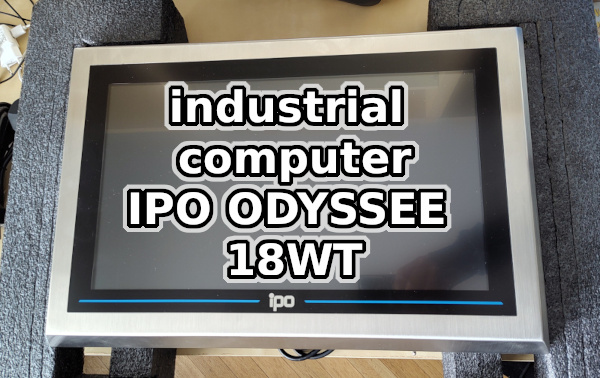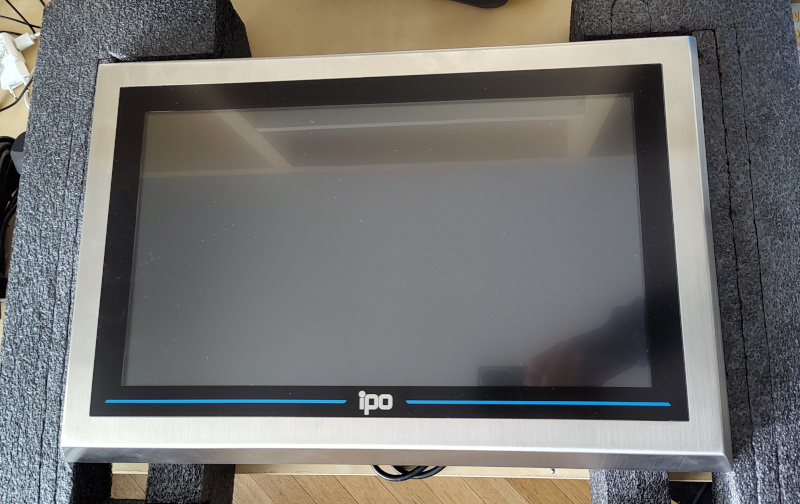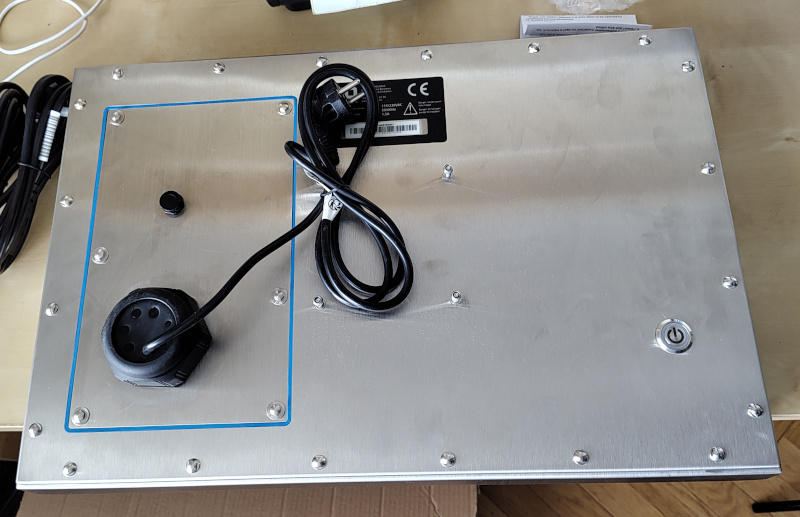Industrial computer IPO ODYSSEE 18WT
March 6, 2024Computers are everywhere these days. In manufacturing, for example. If you need a computer for production, you need an industrial computer. Such a computer is encapsulated and is designed to withstand even rough handling conditions. It can often be waterproof. One option may be the IPO ODYSSEE industrial computer, on which the GNU/Linux OS can be easily installed. You can learn how to install Linux on an IPO ODYSSEE 18WT and about our experience with it in this article.

What is an industrial computer?
An industrial computer is a special type of computer designed and manufactured for use in industrial environments and applications. These computers must be able to withstand harsh conditions, that are often found in industrial environments, such as vibration, extreme temperatures, humidity, dust, and chemicals. They are optimized for reliable operation in these environments, where conventional office computers might not function properly or would be prone to failure.
Industrial computers can be used in various industries such as manufacturing, energy, transportation, healthcare, and many others. They can take various forms, including (embedded computer), panel computers, or rack-mount systems. Their design is often aimed at easy integration with industrial equipment and automation, and may be equipped with special features such as resistant connectors, protection against electrical faults, and extended temperature ranges.
What is an embedded PC?
An embedded PC is a computer system that is integrated into another device or system, often with limited size, power or functionality. These computers are designed to perform specific tasks or functions within a given device or system, such as in industrial automation, medical devices, consumer electronics, automotive systems, and other applications.
Embedded PCs typically consist of hardware and software that is optimized for a specific application. Hardware may include specialized processors, memory subsystems, interfaces for connecting to external devices, and other components. Software can be the development environment, operating system and applications that are designed to meet the requirements of a given application.
Embedded PCs can be designed to be robust and reliable even under extreme conditions, such as high temperatures, vibration or dust, which is often a requirement in industrial applications. These devices are often integrated into a larger system where they perform specific tasks, and can be interconnected with other devices on the network to exchange data and coordinate activities.
Different types of Embedd PC
Some types of Embedd PC can be built on ARM microcontroller, such are simple and have little power,
Others can be built on a ARM SoC and then these can have much more power and operating system and can act as a secure computer.
For example, a Raspberry PI single board computer behaves and can be used as a regular computer.
The IPO ODYSSEE embedded computers are built on the x86 or already modern 64-bit x86_64 architecture. So it is a computer like you have at home, only the packaging, peripherals and components are adapted to the demanding industrial use.
Features of the IPO ODYSSEE 18WT
The main features of the IPO ODYSSEE model 18WT are:
- Ventilation-free (fanless)
- Computer chassis is smooth and 316L stainless steel.
- Waterproof access hatch with IP66 cable grommet
- Use standard connectors/cables
- Wide-angle LED TFT LCD screen size 18.5"
- Capacitive touch layer
- Full HD 1920 x 1080 resolution
- Available in various Intel processor versions. This piece has Pentium® N4200 Quad Core 2.5GHz - TPM (2.0)
- Internal industrial wide range AC or DC power supply
- Rating: front side IP69 - other sides IP66
The computer comes with either a black or blue bezel around the LCD.
In addition to the 18.5" size, a 21.5" and 8.5" model is also available.
The 21" model is labeled ODYSSEE21WT. This model has the same specifications only the display size is 21.5" (resolution is the same).
The model with the 8.5" display size and has a resistive touch layer. This means you can operate it with your gloved hand or an object.
The capacitive touch layer requires a finger touch or a special pen.
Models with a capacitive touch screen have PCAP in the parameters. A model with a resistive touch layer has the designation Res.
The manufacturer is a French company IPO Technologie. The PDF documents that can be found on the Internet are in French only.
Hardware specifications
Each model may have slightly different peripherals and different CPUs. RAM size can be chosen.These are common parameters:
- Pentium N4200 Quad Core 2.5GHz - TPM (2.0) or CoreTM i5-7300U (2.6GHz/3.5GHz) - TPM (2.0)
- SATA
- USB3
- Gigabit Ethernet (RJ45)
- RS232
- Integrated Intel graphics card
- Support UEFI boot
Display parameters
- Brightness: 300 cd/m2
- Contrast: 5000:1
- Maximum viewing angle: Horizontal: 178° - Vertical: 178°
Dust and water protection
The protection rating IP66 and IP69 is the designation of the standard for protection against water and dust ingress.
This standard is defined by the international standard IEC 60529 and is used to characterize the water and dust resistance of electrical equipment.
See wikipedia for more information:
IP code
What does IP66 mean?
IP66 rating means:
- Dust protection: IP66 rated devices are fully protected against dust. Dust cannot get inside the device even with prolonged exposure.
- Water protection: The IP66 rated device is resistant to strong water spray from any direction. This level of protection ensures that the device remains dry even in heavy rain or splashing water from high-pressure washers.
What does IP69 mean?
IP69 means:
- Dust protection: an IP69 rated device is completely dustproof and does not allow dust to penetrate the device.
- Water protection: The IP69 rated device is protected against water ingress at high pressure and high temperatures. This means that it is resistant to splashing water or high-pressure water, such as waterjet cleaning.
Photos
Front view with display:

View of the back side, where the grommet is and behind the grommet and hatch are connectors for USB, Ethernet etc.
The cover needs to be removed to pull the cables through the grommet and then the cables can be tucked into the connectors.
On the back side there is also a button for switching on and off the computer - the so-called ACPI Power Button .

Linux
Hardware List
List devices on the PCI bus using the lspci command:
00:00.0 Host bridge: Intel Corporation Celeron N3350/Pentium N4200/Atom E3900 Series Host Bridge (rev 0d) 00:02.0 VGA compatible controller: Intel Corporation Apollo Lake [HD Graphics 505] (rev 0d) 00:0e.0 Audio device: Intel Corporation Celeron N3350/Pentium N4200/Atom E3900 Series Audio Cluster (rev 0d) 00:0f.0 Communication controller: Intel Corporation Celeron N3350/Pentium N4200/Atom E3900 Series Trusted Execution Engine (rev 0d) 00:12.0 SATA controller: Intel Corporation Celeron N3350/Pentium N4200/Atom E3900 Series SATA AHCI Controller (rev 0d) 00:13.0 PCI bridge: Intel Corporation Celeron N3350/Pentium N4200/Atom E3900 Series PCI Express Port A #1 (rev fd) 00:13.1 PCI bridge: Intel Corporation Celeron N3350/Pentium N4200/Atom E3900 Series PCI Express Port A #2 (rev fd) 00:15.0 USB controller: Intel Corporation Celeron N3350/Pentium N4200/Atom E3900 Series USB xHCI (rev 0d) 00:1f.0 ISA bridge: Intel Corporation Celeron N3350/Pentium N4200/Atom E3900 Series Low Pin Count Interface (rev 0d) 00:1f.1 SMBus: Intel Corporation Celeron N3350/Pentium N4200/Atom E3900 Series SMBus Controller (rev 0d) 01:00.0 Ethernet controller: Intel Corporation I211 Gigabit Network Connection (rev 03) 02:00.0 Ethernet controller: Intel Corporation I211 Gigabit Network Connection (rev 03)
List the device on the USB bus using the lsusb command. Apart from the keyboard, there you can see Ltd eGalaxTouch, which is a touchscreen.
Bus 002 Device 001: ID 1d6b:0003 Linux Foundation 3.0 root hub Bus 001 Device 003: ID 0eef:c002 D-WAV Scientific Co., Ltd eGalaxTouch P80H84 1854 vOD18V_v1-0 k4.08.165 Bus 001 Device 002: ID 413c:2113 Dell Computer Corp. KB216 Wired Keyboard Bus 001 Device 001: ID 1d6b:0002 Linux Foundation 2.0 root hub
More detailed listing using lshw:
Embedded PC ODYSSEE OD18WQPT.
Linux Installation
Installing Linux on this PC is easy. The computer is able to boot from a USB flash drive and a USB connector is available for the user. So just prepare the installation USB flash drive and boot the install from that. For example, you can download the installation image of Debian distribution. and use the dd command (or another tool) to upload the installation image to a USB flash drive
If you had very special requirements or a custom board, typically built on a ARM SoC, then you'd have to prepare your own system, and that's what Yocto Project is for, where you build your own distribution tailored to your needs and, more importantly, to your specific hardware.
The functionality and operation of the PC is seamless.
The network card works already when installed and so does the touch layer.
No extra module (driver) needs to be installed or configured.
The display and graphics card also works plug&play.
Video tutorial
For those who have never installed Linux, I have made
footage of the installation of the Debian distribution on the IPO ODYSSEE 18WT Embedded PC:
Kiosk
For real-world use, you'll probably want no app menu bar to be visible, so that there's only one app running on the device, which will automatically launch on startup. What you want is a so-called kiosk mode
To enable kiosk mode, install a minimal installation of Debian. That is, only the base system and ssh, do not install any graphical environment! You then need to configure the system and run the appropriate application. For example, you can run the chrome/chromium web browser in kiosk mode, so that the user does not see the bar and the browser launches on a predefined web page.
Linux Installation and Configuration
Whatever your project or whatever hardware you have definitely consider installing Linux. Linux is flexible so you can adapt it to your needs, it's low maintenance, stable and secure. These features will save you a lot of time, trouble and money in the long run. If you want to take advantage of the Linux operating system in your company, for example, you want to install Linux on a server or any other device and configure Linux in a customized way, then feel free to contact me.
Articles on a similar topic
Lenovo Thinkpad P14s battery life and UEFI/BIOS flashing
Which mouse to choose for my computer?
Samsung S24H850 monitor
TUXEDO Pulse 15 - Gen2
How to connect a computer to a mobile phone running Android
Data backup
Banana Pi R1 case
Computer with MSI B85-G43 motherboard and Intel Xeon E3 1226 processor
Single board ARM computer Banana PI R1
How to use an SSD and TRIM
Using TouchBook in practice
Compal FL90 and GNU/Linux
Disassembled computer disk
Newsletter
If you are interested in receiving occasional news by email.
You can register by filling in your email
news subscription.
+





